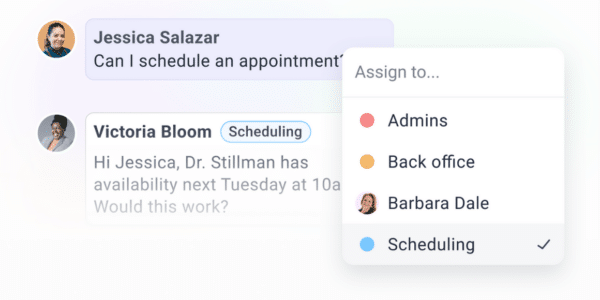The management of patient centered care can make or break the healthcare experience.
We all strive to center the visit on the patient, but there are many moving pieces to the care experience that can put us off target.
There are things you can do, today, to improve the experience that will keep your patients both happy and healthy. The good news is, many of the things you can do are just incredibly simple.
Just think about what you would want as a patient.
It can be as easy as using their name in a sentence or knocking before you enter a room. Common courtesy goes a long way in any relationship. Healthcare is no different.
Most organizations are moving towards patient centered care because it not only improves patient satisfaction, but it improves the quality and effectiveness of care as well. It also empowers patients to work alongside their practitioners and help find ways to personalize their care together. Here are 8 simple ways to improve the management of patient centered care in your organization.
1. Be present for your patients
Knowing your doctor is there every step of the way differentiates a great patient experience from a lackluster one.
People skills are just as important as great communication between patient and provider.
Whether over video calls or texting, acknowledging the patient by their first name is just the beginning in personalizing care. For example, eye contact and active listening during in-person or virtual visits will create trust and comfort.
These are effective everyday practices that you can use to be more present as a provider.
2. Respect their personal preferences
Healthcare workers interact with all different kinds of people on any given day. It is fundamental to understand all backgrounds when considering your management of patient centered care.
Don’t get us wrong, it can get difficult to personalize each patient’s care journey. This is where technology can be such an important asset. Working with solution providers that understand both what the patient wants out of their care experience and the way you work as a care team can pay large dividends.
For example, the ability to tag patient conversations in your communication software can go a long way in improving the management of patient centered care.
Tagging, segmenting, and referencing the patients in your roster can provide you the keys to personalization that will create strong bonds and deliver efficient, effective care.
Imagine going into a conversation with a patient you haven’t met before and knowing what language or pronouns they prefer because one of your colleagues tagged their conversations.
It is the little things that matter in a patient relationship, and technology, when used correctly, can help to foster the strong bonds you want to form.
3. Tailor to their telehealth needs
In telehealth there are ways to make care more accessible beyond video visits.
This may be solving the patient’s healthcare needs through automated appointment reminders or webchat on your website. Or, to make it even more personalized – chat with them in real time through two-way texting. Give them the support they need and offer guidance along the way. It will make a huge difference in the patients lives and your own.
4. Ask about their preferred method of communication
Calling can be overwhelming for both patients and healthcare organizations.
On the flip side, everyone reads their texts.
Simply asking if a patient would like to be texted instead can make the care experience much more streamlined.
You may also find that they want to video chat or live chat with the care team on the website. Finding which communication tools work best for the patient builds trust and allows you to improve the management of patient centered care.
5. Send them personalized messages
No one likes spam.
It’s annoying and impersonal. That’s exactly why people also hate waiting on hold.
The management of patient centered care focuses in on making the experience personal.
Patients want their needs to be acknowledged and a simple text checking in on them can make a huge difference. Even after a patient leaves your facility, knowing they will be checked on will not only improve the quality of care but patient satisfaction as well. The way you treat them after they leave may be the thing that sets you apart from other healthcare organizations and gives them a reason to return.
6. Earn their trust
When we talk about the management of patient centered care and using multiple communication channels to complement in-person visits and phone calls, one question always comes up.
How safe is it to text or video visit or webchat with your doctor?
The answer is, very safe…as long as you choose your software solution wisely.
There are a lot of communication tools out there. The problem is that many of these tools were built for things like e-commerce or consumer subscription services.
When you look at communication tools built for healthcare specifically, the pool of options gets small, fast!
As a first pass when you’re considering a communication solution for the management of patient centered care, make sure it is HIPAA-compliant.
It should go without saying that ensuring these personalized communication methods are compliant is key to patient centered care because it puts the patient at ease knowing you are keeping their information safe.
Another tip is to find a solution that offers the flexibility to switch between encrypted and non-encrypted messages according to the preferences of your patients. Many software solutions do not offer this. Finding ones that do allows you to truly center in on what the patient wants out of their relationship with their doctor. A relationship built on trust and safety.
7. Develop care strategies together
Working together with the patient to personalize their path to care is so important in the management of patient centered care. Give patients the option to decide what works for them. Many care preferences, methods and tools have appeared or have become more widely used since the start of the COVID-19 pandemic. Having the ability to cater to your patient will set you apart from other care organizations.
Again, many of these are incredibly simple to implement, especially with the right technologies. Some examples:
- Provide the option to wait in their car instead of the waiting room, sending a text when the doctor is ready.
- Offer video visits instead of going to the office to ensure safety for higher risk patients.
- Offer medication refills without ever having to wait on hold by allowing the patient to text in.
These care strategies maintain the personalization between a patient and a provider, but also makes the care process more efficient as well.
8. Educate patients about telehealth options
While telehealth may seem like a breeze for some, it may take some patients time to understand.
Telehealth has eliminated some of the barriers that made healthcare difficult to access. As you work to improve management of patient centered care, be sure to make telehealth options not only accessible, but easy for them to understand.
Set some time aside to help your patient learn about the tools you use. This can be as simple as walking them through video visits or alerting them of new check in processes that make it easier and safer for them to get in to see the doctor.
Your ability to educate with empathy is so meaningful to a patient and can lead to long lasting relationships.
These are just a few of the many ways to connect with your patients on a personal level. The management of patient centered care should be the foundation of your organization.
The best part? You don’t have to do it all at once. Even minor victories help the patients and your practice succeed, so why not start small?


